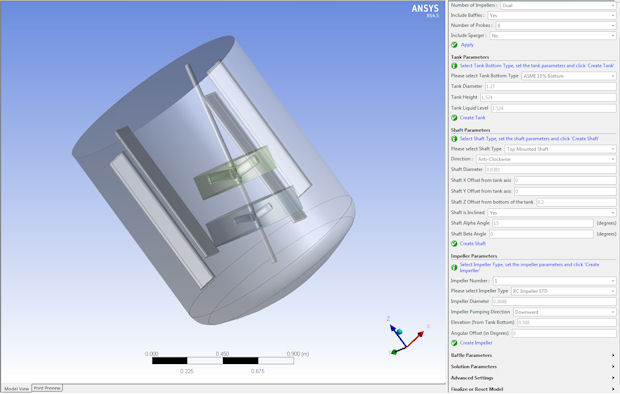Simulating Mixing Tank & Bioreactor Performance
Latest News
July 31, 2014
 Dear Desktop Engineering Reader:
Dear Desktop Engineering Reader:
What goes on in a mixing tank seems a natural fit for CFD (computational fluid dynamics) analysis. For example, you want to make sure materials mix efficiently with the least amount of blend time. Or, if your mixing process relies on microorganisms to play a part, you need to find the balance between areas of low and high agitation so that you control your population of microorganisms. The problem is, however, that impellers, shafts, baffles and assorted geometric complexities of a mixing tank can present a formidable CFD challenge.
Today’s Check it Out takes you to an ANSYS Tech Tip intended to show you that CFD analyses of mixing tanks do not have to be difficult. Smack in the middle of the page you land on a video that takes you through a complete mixing tank simulation to make that point clear. Called “Simulating Mixing Tank & Bioreactor Performance – Minimizing Mixing Time and Cell Damage,” this 9-minute 45-second video (no registration) provides a demonstration of a dedicated set of features in ANSYS for CFD-based analyses of mixing tanks.
The gist of the ANSYS solution is that it uses a lot of automation to lessen the drudgery of geometry and mesh creation. It should be noted here that CFD mavens can use the solution set’s automation capabilities to handle the geometry and meshing then interrupt the automation to set up more complex simulations like multiphase flows if they choose.
How this works is that you select the Mixing Template from ANSYS Workbench. This returns a full ANSYS Fluent CFD analysis action plan with mixing, blending and exposure analysis steps as well as results processing. You enter in your geometry and mixing conditions then click run. ANSYS executes the design analysis and builds a report automatically.
The video demonstrates how you do this and what the report offers. So, for example, the video shows that during the geometry creation process, you step through and define the mixing tank components as well as the tank’s dimensions from pull-down menus and prompts to fill in parameters. Where applicable, the pull-downs and fill-ins are pre-populated with selections of industry standards.
You create components such as impellers, probes or baffles similarly. As an example, for a shaft, you’re prompted to select a mounting position and direction of rotation then specify the shaft’s dimensions, axes offsets, inclination and so on.
All of these components are presented in a side panel. There’s also a certain amount of error checking. In the video, the presenter makes an error entering data on some baffles, which the software flags.
The report summarizes blend time and exposure analysis information. Also directly available in the report are key parameters like velocity contours and nifty animations of blending.
The “Simulating Mixing Tank & Bioreactor Performance” Tech Tip page comes with a variety of white papers, case studies, technical briefs and on-demand webinars so that you can further explore ANSYS CFD solutions. Of particular note is the on-demand webinar “Streamline Mixing Analysis and Enable Quality by Design Using ANSYS Workbench.”
This 57-minute presentation (registration required) demonstrates with greater depth how ANSYS Workbench can help you to conduct multivariate analyses with a lot of automation in all phases of a CFD problem. It uses a fermentation process as its example project, so you’re looking at engineering problems encountered in hydrodynamic and mass transfer environments. The solution involves CFD coupled with statistical tools.
“Simulating Mixing Tank & Bioreactor Performance” is informative and easy to follow. There’s something about it that also makes it fun to watch. The short of it, however, is that the process ANSYS Mixing Template provides really does seem to make CFD mixing analyses easy to set up and run. Hit today’s Check it Out link and take 10 minutes, give it a look and make your own call.
Thanks, Pal. – Lockwood
Anthony J. Lockwood
Editor at Large, Desktop Engineering
Go here for the “Simulating Mixing Tank & Bioreactor Performance” web page.
Subscribe to our FREE magazine, FREE email newsletters or both!
Latest News
About the Author
Anthony J. Lockwood is Digital Engineering’s founding editor. He is now retired. Contact him via [email protected].
Follow DE






